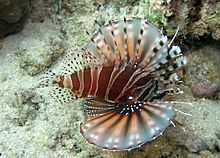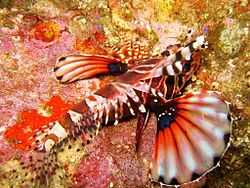Dendrochirus zebra
| Zebra turkeyfish | |
|---|---|
 | |
| Scientific classification | |
| Kingdom: | Animalia |
| Phylum: | Chordata |
| Class: | Actinopterygii |
| Order: | Scorpaeniformes |
| Family: | Scorpaenidae |
| Genus: | Dendrochirus |
| Species: | D. zebra |
| Binomial name | |
| Dendrochirus zebra (G. Cuvier, 1829) | |
Dendrochirus zebra, known commonly as the Zebra turkeyfish or Zebra lionfish among other vernacular names, is a species of marine fish in the family Scorpaenidae.
Zebra turkeyfishes are widespread throughout the tropical waters of the Indo-West Pacific including the Red Sea. However, they have been found in the Atlantic Ocean as well, up to the coast of New York. This population is most likely to be the result of aquarists releasing their pets into the wild.
Description
The zebra turkeyfish is an unusual looking fish with vertical stripes in orange, white and black on the body, and large, banded fan-like pectoral fins that flare out on either side as the fish lies on the seabed. The front dorsal fin is made up of thirteen tall, quill-like spines and the second dorsal fin has ten to eleven soft rays. The anal fin has three spines and about ten soft rays. The second dorsal fin, the anal fin and the rounded caudal fin are transversely banded in black and white. This fish grows to a maximum length of about 25 cm (10 in).[1]
Distribution and habitat
The zebra turkeyfish is native to the Indo-Pacific region from the Red Sea to Indonesia and eastern Australia. It is found in inshore waters down to a depth of about 80 m (262 ft). It is a bottom-dwelling species and is found on coral, pebble, and rock bottoms on reef flats, outer reefs and lagoons and also in caves, sometimes in small groups.[1]
Biology
This member of the scorpion fish family has thirteen venomous spines along its back, used to defend itself. These spines are connected with a clear film-like membrane. These fish are slow-moving and peaceful, but can be dangerous. They have a habit of resting in places hidden from light such as under a rock or a piece of coral.[2] All lionfish are immune to each other's venom and all are solitary fish. Despite their obvious advantage, zebra lionfish feed only on small crustaceans, and are in turn preyed upon by groupers.

References
- ↑ 1.0 1.1 "Dendrochirus zebra (Cuvier, 1829): Zebra turkeyfish". FishBase. Retrieved 2013-12-19.
- ↑ Lieske, E. and R. Myers, 1994. Collins Pocket Guide. Coral reef fishes. Indo-Pacific & Caribbean including the Red Sea. Haper Collins Publishers, 400 p.